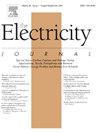Powering agricultural revival: How solar-based irrigation is transforming Northeast Syria's war-torn fields
IF 2.2
Q1 Social Sciences
引用次数: 0
Abstract
This study examines the impact of solar-powered irrigation on agricultural recovery in the Abadan sub-district of northeast Syria, a region severely affected by war and drought. The research evaluates five dimensions of agricultural recovery: profitability, productivity, job creation effects, investment attraction, and household expenditures. The analysis, conducted using propensity score matching, indicates that solar-powered irrigation significantly enhances agricultural profitability, with solar users earning an average of $20.42 more per acre compared to diesel users (p = 0.001). Wheat productivity showed a modest increase from 0.151 to 0.179 tons per acre, though the difference was statistically insignificant (p = 0.365). Similarly, solar-based farms generated an average of 87.42 working days per year, compared to 75.30 days for diesel-based farms, but this difference was also not statistically significant (p = 0.60). Despite these mixed outcomes, the study highlights a significant shift towards the cultivation of summer crops, such as cotton, facilitated by more reliable water supply provided by solar-powered irrigation. These findings emphasize the importance of targeted interventions, including the promotion of advanced irrigation techniques and financial support for infrastructure development. Such measures are critical for maximizing the benefits of solar-based irrigation and ensuring broader, more sustainable agricultural recovery in the region.
为农业复兴提供动力:太阳能灌溉如何改变叙利亚东北部饱受战争蹂躏的田野
本研究探讨了太阳能灌溉对叙利亚东北部阿巴丹分区农业恢复的影响,该地区受到战争和干旱的严重影响。研究评估了农业恢复的五个方面:盈利能力、生产率、创造就业效应、投资吸引力和家庭支出。利用倾向得分匹配法进行的分析表明,太阳能灌溉显著提高了农业收益率,与柴油用户相比,太阳能用户平均每英亩多赚 20.42 美元(p = 0.001)。小麦生产率略有提高,从每英亩 0.151 吨提高到 0.179 吨,但差异在统计上并不显著(p = 0.365)。同样,使用太阳能的农场每年平均产生 87.42 个工作日,而使用柴油的农场则为 75.30 个工作日,但这一差异在统计学上也不显著(p = 0.60)。尽管结果好坏参半,但研究强调,由于太阳能灌溉提供了更可靠的供水,种植棉花等夏收作物的趋势得到了明显改善。这些发现强调了有针对性的干预措施的重要性,包括推广先进的灌溉技术和为基础设施发展提供财政支持。这些措施对于最大限度地发挥太阳能灌溉的效益和确保该地区更广泛、更可持续的农业复苏至关重要。
本文章由计算机程序翻译,如有差异,请以英文原文为准。
求助全文
约1分钟内获得全文
求助全文
来源期刊

Electricity Journal
Business, Management and Accounting-Business and International Management
CiteScore
5.80
自引率
0.00%
发文量
95
审稿时长
31 days
期刊介绍:
The Electricity Journal is the leading journal in electric power policy. The journal deals primarily with fuel diversity and the energy mix needed for optimal energy market performance, and therefore covers the full spectrum of energy, from coal, nuclear, natural gas and oil, to renewable energy sources including hydro, solar, geothermal and wind power. Recently, the journal has been publishing in emerging areas including energy storage, microgrid strategies, dynamic pricing, cyber security, climate change, cap and trade, distributed generation, net metering, transmission and generation market dynamics. The Electricity Journal aims to bring together the most thoughtful and influential thinkers globally from across industry, practitioners, government, policymakers and academia. The Editorial Advisory Board is comprised of electric industry thought leaders who have served as regulators, consultants, litigators, and market advocates. Their collective experience helps ensure that the most relevant and thought-provoking issues are presented to our readers, and helps navigate the emerging shape and design of the electricity/energy industry.
 求助内容:
求助内容: 应助结果提醒方式:
应助结果提醒方式:


